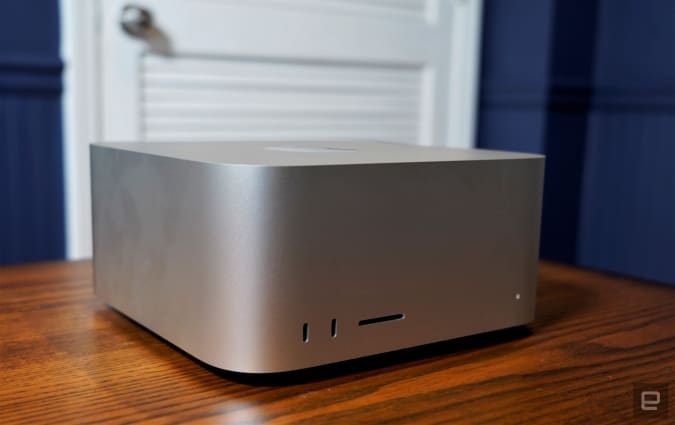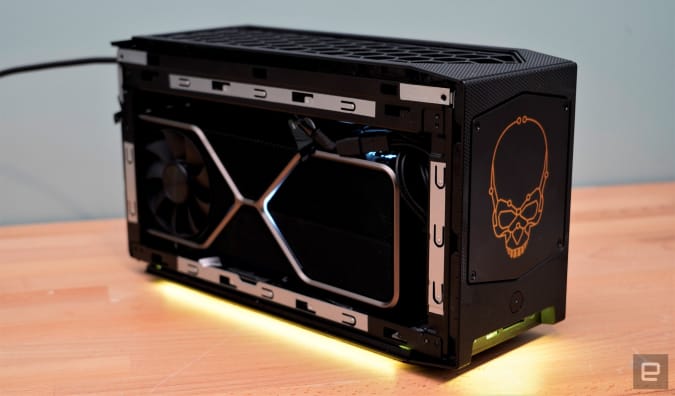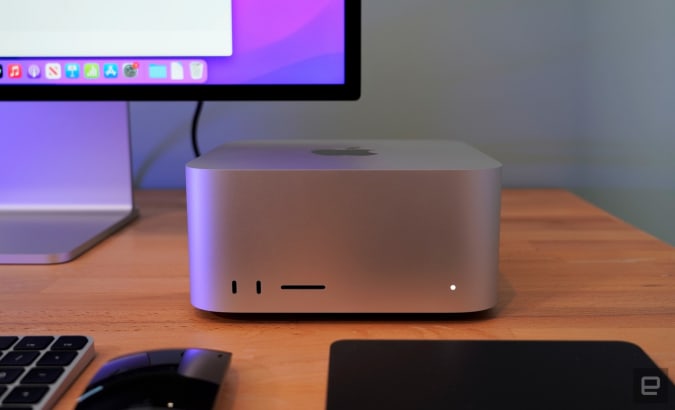Mac Studio review: Apple’s Big Mac mini
Image Credit: Devindra Hardawar/Engadget
While Apple’s custom processors were miraculous on laptops — delivering speed and power efficiency like we’ve never seen before with x86 CPUs — desktop workstations are a far greater challenge. AMD has been able to cram 64 cores into the Ryzen Threadripper 3990X, a monstrously powerful chip with a power-hungry 280-watt TDP (thermal dynamic profile). But then again, that chip can cost well over $8,000.
Apple’s more direct competition is the 16-core Ryzen 9 5950X. While the company didn’t offer specific details on its chip thermals, it noted that the M1 Ultra can reach up to 90 percent higher performance in the same power envelope as the “fastest 16-core PC desktop chip available.” That’s most likely the 5950X. Apple adds that the Ultra can match that PC chip’s peak performance while using 100 watts less power.
|
Geekbench 5 CPU |
Cinebench R23 |
Disk speed (top reads/writes) |
|
|
Apple Mac Studio (M1 Ultra) |
1,785/23,942 |
1,537/24,078 |
9.86 GB/s / 6.39 GB/s |
|
Apple Mac Studio (M1 Max) |
1,715/12,642 |
1,534/12,314 |
9.23 GB/s / 6.36 GB/s |
|
Apple MacBook Pro (16-inch, M1 Max) |
1,783/12,693 |
1,524/12,281 |
5.1 GB/s / 6.2 GB/s |
|
Intel NUC 12 Extreme (Intel Core i9-12900, NVIDIA RTX 3080) |
1,762/13,371 |
6.1 GB/s / 5 GB/s |
The big takeaway: You can expect the Mac Studio to deliver a lot of performance without generating much heat or fan noise. And, for the most part, that’s what I found during my testing. The M1 Ultra-powered Mac Studio achieved the highest Geekbench 5 and Cinebench R23 multithreaded scores we’ve ever seen, all without spinning up its fan or working up a sweat. The M1 Max model, meanwhile, scored the same as the Max-powered 16-inch MacBook Pro, and well above other 10-core systems. Intel’s 14- and 16-core 12th-gen chips scored slightly higher than the M1 Max in multithreaded performance, but the M1 Ultra trounced them completely.
I’m not a professional video editor, and I don’t work with complex 3D models regularly. So I relied on a few Apple-provided projects to get a better sense of the Mac Studio’s real-world performance: an 8K video edit in Final Cut Pro, and a 54-million voxel CT scan in Horos Mobile. I was able to export an 8K version of that 34-second video in 23 seconds on both Mac Studios (the M1 Max model took 0.2 seconds longer). There was a slightly bigger difference when exporting to 4K: the M1 Ultra Mac Studio took 23.5 seconds, while the M1 Max took an additional two seconds.
Devindra Hardawar/Engadget
Both systems also let me rotate and explore that massive Horos Mobile CT scan without any major slowdowns. Apple’s unified memory architecture is particularly helpful for large files, since it gives the GPU direct access to all of the system’s RAM. PC GPUs, meanwhile, are limited by their onboard memory. NVIDIA’s flagship RTX 3090 packs in 24GB of VRAM, but our Mac Studios could give Horos Mobile, or any other app, access to a big chunk of their 64GB or 128GB of RAM if necessary. That alone could make them tempting for editors working with feature-length 8K videos.
So sure, the Mac Studios can deliver a ton of performance. But there are plenty of downsides when compared to PC workstations. For one, since they’re Macs, there aren’t many games to play when you need some R&R. Apple Arcade titles are decent distractions, and there are a handful of older and indie Steam games that run on the Mac Studio, like Hitman and Shadow of the Tomb Raider. But you can give up hope on playing new titles like Elden Ring, or using PC VR headsets. Apple’s M1 chips are based on a mobile ARM architecture, so you can’t install Windows on the Mac Studio like you could with Intel-based Macs. External GPUs are also out of the question, since Apple’s Silicon depends on having direct access to GPU hardware (an eGPU would just be slowed down by the Thunderbolt interface).

Devindra Hardawar/Engadget
You can’t upgrade the Mac Studio either, which is a bummer if you wanted to jump to faster SSDs in a few years. Their RAM is built right into the M1 chips, which means there’s no physical way to expand the memory either. I’d wager many creatives wouldn’t have much of a reason to upgrade anyway, though. The M1 Max model comes with 32GB of RAM by default, while the Ultra configuration has 64GB. The SSDs on both systems are also incredibly fast, delivering almost 10 Gigabytes per second read speeds and over 6 GB/s in writing performance. Those are the highest figures we’ve ever clocked on SSDs.
As great as the overall Mac Studio experience is, it’s hampered a bit by Apple’s accessories. The Magic Keyboard is fine to type on, but I’d still like more key depth. And the Magic Mouse is, once again, a disastrous design. You can only charge it from the bottom, and it’s simply too small for me to use comfortably. Instead, I gravitated towards the Magic Trackpad, which feels more like using one of Apple’s laptops. If you’re a PC user jumping ship to Macs, I’d recommend bringing over your favorite Logitech hardware instead.

Devindra Hardawar/Engadget
If you just want a powerful Mac desktop, and you’re fine with the lack of upgradability, the Mac Studio will serve you well for years. But if you’re concerned you may outgrow it soon, you’ve also got plenty of PC workstations to choose from. Intel’s NUC 12 Extreme (above) is a bit larger, but it can be equipped with a full-sized graphics card and you can upgrade the RAM and SSDs as much as you want. That machine only comes as a DIY kit, but you’ll be able to buy pre-configured models from third-party retailers eventually. Alternatively, you could always go for a pre-built small-form-factor PC from builders like Origin, but expect to pay more than the cheapest Mac Studio.

Devindra Hardawar/Engadget
As I mentioned up top, Apple’s revamped Mac Pro could be a compelling option for power-hungry creators. But it would likely cost well over $6,000 at a minimum, based on the pricing for the last model and the fact that the $4,000 Mac Studio exists. At this point, the Mac Pro seems like it’s only meant for production houses or people with seriously deep pockets.
Unlike the iMac Pro, it’s easy to tell who the Mac Studio is for: People who demand power, ports and reasonably priced hardware. It’s taken a while, but now Apple finally has a Mac desktop that can go toe-to-toe with PC workstations under $5,000.
All products recommended by Engadget are selected by our editorial team, independent of our parent company. Some of our stories include affiliate links. If you buy something through one of these links, we may earn an affiliate commission.
For all the latest Technology News Click Here
For the latest news and updates, follow us on Google News.
